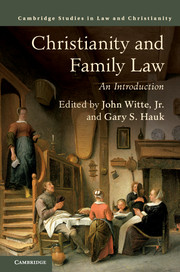Book contents
- Christianity and Family Law
- Law and Christianity
- Christianity and Family Law
- Copyright page
- Dedication
- Contents
- Illustrations
- Contributors
- Preface
- Introduction
- 1 Moses, the Prophets, and the Rabbis
- 2 Jesus and St. Paul
- 3 Emperor Constantine
- 4 St. Augustine of Hippo
- 5 St. John Chrysostom
- 6 Emperor Justinian
- 7 Theodore Balsamon
- 8 Gratian
- 9 Peter Lombard
- 10 Popes Alexander III and Innocent III
- 11 St. Thomas Aquinas
- 12 Martin Luther
- 13 John Calvin
- 14 King Henry VIII
- 15 Thomas Sanchez
- 16 John Selden
- 17 Mary Wollstonecraft
- 18 Abraham Kuyper
- 19 Emil Brunner
- 20 Popes Leo XIII and Pius XI
- 21 Pope Paul VI
- 22 Pope John Paul II
- 23 Paul Evdokimov
- 24 Derrick Sherwin Bailey
- 25 Jean Bethke Elshtain
- Bibliography
- Index
- References
Bibliography
Published online by Cambridge University Press: 12 October 2017
- Christianity and Family Law
- Law and Christianity
- Christianity and Family Law
- Copyright page
- Dedication
- Contents
- Illustrations
- Contributors
- Preface
- Introduction
- 1 Moses, the Prophets, and the Rabbis
- 2 Jesus and St. Paul
- 3 Emperor Constantine
- 4 St. Augustine of Hippo
- 5 St. John Chrysostom
- 6 Emperor Justinian
- 7 Theodore Balsamon
- 8 Gratian
- 9 Peter Lombard
- 10 Popes Alexander III and Innocent III
- 11 St. Thomas Aquinas
- 12 Martin Luther
- 13 John Calvin
- 14 King Henry VIII
- 15 Thomas Sanchez
- 16 John Selden
- 17 Mary Wollstonecraft
- 18 Abraham Kuyper
- 19 Emil Brunner
- 20 Popes Leo XIII and Pius XI
- 21 Pope Paul VI
- 22 Pope John Paul II
- 23 Paul Evdokimov
- 24 Derrick Sherwin Bailey
- 25 Jean Bethke Elshtain
- Bibliography
- Index
- References
- Type
- Chapter
- Information
- Christianity and Family LawAn Introduction, pp. 413 - 428Publisher: Cambridge University PressPrint publication year: 2017



